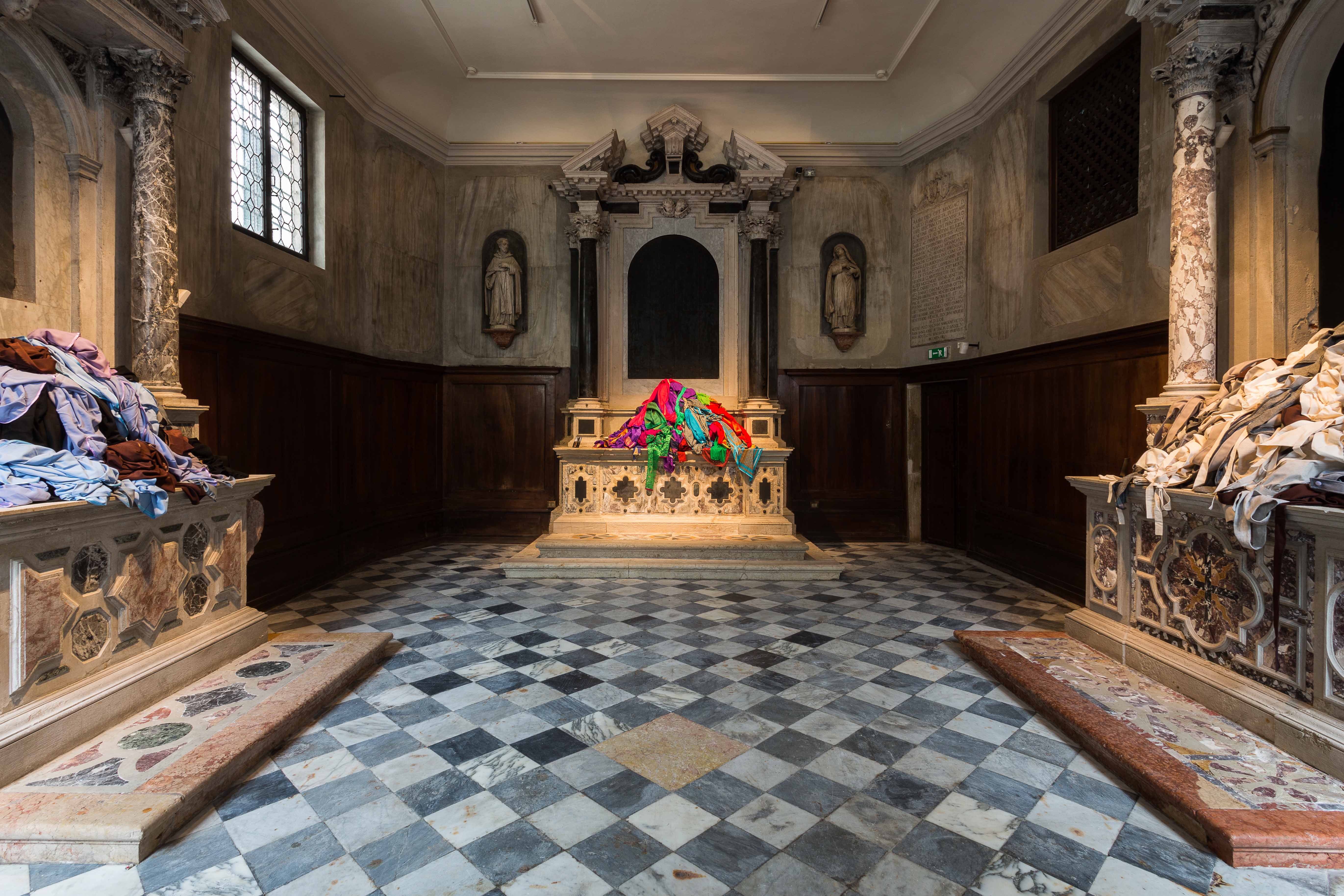You have no items in your cart. Want to get some nice things?
Go shopping
This summer notes the 56th Venice Biennale art exhibition, titled All The World’s Futures. The work of over 136 artists from 53 countries is featured at the Biennale. We spoke to Patricia Cronin about her installation ‘Shrine For Girls’ featured at this year’s Biennale.
Paolo Baratta, president of la Biennale de Venezia, introduced the Biennale, ‘The world before us today exhibits deep divisions and wounds, pronounced inequalities and uncertainties as to the future…And once more, the Biennale observes the relationship between art and the development of the human, social, and political world, as external forces and phenomena loom large over it. Our aim is to investigate how the tensions of the outside world act on the sensitivities and the vital and expressive energies of artists, on their desires and their inner song.’
We see these wounds and inequalities gathered and displayed in Patricia Cronin’s ‘Shrine for Girls,’ which commemorates the many girls around the world who have been subjected to repression and violence. In her press release, she commented, “Commemorating their spirit, this dramatic site-specific installation is a meditation on the incalculable loss of unrealized potential and hopelessness in the face of unfathomable human cruelty; juxtaposed against the obligation and mission we have as citizens of the world to combat this prejudice.”
Based in the divine Church Of San Gallo, the installation sits on three altars, honouring the young girls, noting their unrecognised and unfulfilled ability and possibility, and relaying the deep disservice the world is doing to young girls.
As you enter the church, the altar on your left displays hijabs, representing the 276 girls kidnapped in April 2015 by Boko Haram in Nigeria. The location of the Chibok girls is still unknown. The central altar displays strikingly beautiful bright traditional sari worn by girls in India, three of whom were gang raped and hung from trees. The right altar is a pile of aprons and uniforms, signifying the mistreatment of girls at the Magdalene asylums and Laundries, forced labour institutions for young women in Ireland, the UK and America as recently as 1996. The three shrines work together in harmony to display mutual support and respect for women around the world.
Litro: What made you choose to use the clothing of these particular groups of women?
Patricia Cronin: When the Italian curator, Ludovico Pratesi invited me last May to make this exhibition, we were in my Gowanus Brooklyn studio to look at a project of sculptures about the global crisis in masculinity as a response to Boko Haram kidnapping the Chibok students in Nigeria, that in part was inspired by Hal Foster’s review of three new Medieval and Renaissance art history books in the London Review of Books.
But a couple weeks later when I flew over to Italy for a site visit and saw Stephen Frears’ film “Philomena” on the plane my concept changed. Having grown up Irish Catholic in New England I was shocked that I knew nothing about the Magdalene Laundries and was incredibly moved. Our 24 hour new cycle times delivers such tragedy and devastation all the time that it becomes easy to numb yourself to the reality of irrevocable human cruelty.
I was sitting in Campo San Gallo contemplating the exhibition when a large group of tourists from India arrived at their hotel. Earlier that week two cousins Pushpa and Murti were gang raped and lynched, left to hang on mango tree in Northern India. I wondered what their fellow Indians (albeit from a much higher cast) thought. And that’s when I realized I should be focusing on what’s actually happening to the girls and young women, not the men. Chiesa di San Gallo is a de-consecrated church and no longer a place of worship. But it is still owned by the Diocese of Venice and there are some restrictions including you can’t hang anything on the walls, you are only allowed to use the three stone altars, which was perfect.
I had three horrific events of girls being persecuted simply because of their gender stuck in my head and each with completely different clothing. Since their bodies weren’t treated with dignity while they were alive, and their bodies are missing or murdered, I consider the girls martyrs and their clothing are their relics. Unlike religious martyrs, there is no glory in their death, no other worldly triumph.
Litro: What do you think about the materialistic conventions of clothing as a means of masking the body and developing an identity for yourself?
Patricia Cronin: The clothing I’ve used in creating shrines to these girls and women is clothing worn by regular people, from their localities and these specific recent and historic atrocities around the world: Africa, India & Europe, mainly Ireland, but also the United Kingdom, Germany, France, Italy and the United States. Very wealthy people from all over the world came to the Venice Biennale, walked by the leading fashion houses’ stores in Venice (some of these people are actually some of the biggest clients of the brands) wore their clothes and walked inside my exhibition of ordinary girls and women’s clothing… and wept.
This project is less about clothing masking the body or how people identify themselves through the clothes they wear and more about what we all have in common underneath the clothes – our shared common humanity. We all have bodies; we’re all made up of the same ingredients, bone, blood, organs, muscles, brains, and hearts, etc. The American Billionaire Warren Buffet has coined the phrase “ovarian lottery.” It is just a stroke of luck that I am not one of the Chibok students, Magdalene Laundry girls or one of the raped and lynched cousins in India. And just because I’m not one of them doesn’t mean I shouldn’t think about them, care about them, have an emotional response, or do nothing and remain silent.
Litro: Ludovico Pratesi commented on the Shrine For Girls website that the installation is ‘a hymn to woman, to her often in expressed potential.’ How would you say the clothes used express the potential of women?
Patricia Cronin: “Inexpressed potential” because their given birthright as human beings should be to life to their fullest potential. And when you are imprisoned or killed because of your gender, you are prohibited from doing that. Those girls and woman are missing or dead. The clothes are virtually formless. They should have the form of the girl inhabiting them; instead, they are lifeless. We all know what shape they should be if the girls and women are wearing them. But they can’t. Irrational and immoral acts by men have prevented the clothing to take their intended shape. They should be wearing them, going about their lives, going to school, helping their parents, playing, day dreaming, laughing. But they can’t.
Litro: How do you think the Shrine For Girls works with the title of this year’s Venice Biennale ‘All The World’s Futures’ and how does this motif of potential tie into this title?
Patricia Cronin: Okuwi Enwezor’s premise of the “disquiet of our times” resonates perfectly with my solo Collateral Exhibition Shrine For Girls. That’s why he chose Shrine For Girls, Venice. I made real a place for reflection, prayer, mourning for all the girls missing or murdered.
Many women and men have become emotional in my exhibition. When you are moved, when the art has reached you and caused a physical and/or emotional sensation – you want to do something. On the wall text as you exit the exhibition, I’ve identified 3 non-profit organizations related to the three tragedies; CamFed (Campaign for Female Education in Sub-Saharan Africa), The Gulabi Gang in India and Justice for the Magdalenes in Ireland. You can learn more about what they do and donate money if you wish. And I have pledged 10% of any profits from this exhibition to these three organizations. We all have the potential to act and try to make the world a better place.

About Isabel Gonzalez-Prendergast
Isabel is particularly interested in international literature, learning about different cultures and philosophies.




